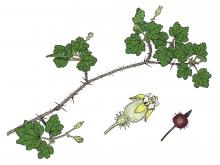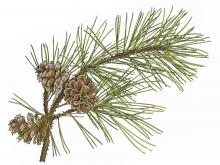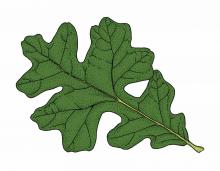Trees, Shrubs and Woody Vines
Media

Species Types
Scientific Name
Symphoricarpos orbiculatus
Description
Buckbrush, or coralberry, grows throughout Missouri. This familiar thicket-forming shrub bears dense clusters of pinkish-red berries that persist through most of the winter.
Media

Species Types
Scientific Name
Ribes cynosbati
Description
Prickly gooseberry occurs mostly in the eastern half of Missouri. Its spine-covered berries turn reddish purple when ripe. Despite the prickles, they are edible.
Media

Species Types
Scientific Name
Ribes missouriense
Description
Missouri gooseberry is our state’s most widespread and common gooseberry. People brave its prickly stems to collect its tart, tasty fruits to make pies, jams, and jellies.
Media

Species Types
Scientific Name
Cercis canadensis
Description
Eastern redbud is a native shrub or small tree that is distinctly ornamental in spring with small, clustered, rose-purple flowers covering the bare branches before the leaves.
Media

Species Types
Scientific Name
Fraxinus americana
Description
White ash leaves turn shades of yellow and purple in fall, and that is one reason it has been a popular landscaping tree. Many birds and mammals feed on the paddle-shaped seeds.
Media

Species Types
Scientific Name
Pinus echinata
Description
Existing in thousands of acres of nearly pure stands, shortleaf pine was once the dominant tree in much of the Missouri Ozarks. Today, Missouri’s only native pine tree is recovering from the extensive logging that had exhausted its old-growth stands by the 1920s.
Species Types
Scientific Name
Tsuga canadensis
Description
Eastern, or Canadian hemlock is usually encountered only in landscaping in Missouri. But based on one instance in Oregon County, we know it can reproduce and spread here on its own. So if you find it on a hike, it was almost certainly planted there at some point. Look around for a cistern, old home foundation, and other persisting garden plants nearby.
Media

Species Types
Scientific Name
Juniperus virginiana
Description
By far the most common native conifer in the state, eastern red cedar is useful for its aromatic, red wood and beloved for its greenery, its resinous blue “berries,” and the spicy odor it lends the outdoors.
Media

Species Types
Scientific Name
Quercus stellata
Description
Post oak has long been favored for fence posts and was valued by American pioneers. It has distinctive cross- or ghost-shaped leaves. It grows in rocky upland woodlands and in flatwoods on broad ridges.
Media

Species Types
Scientific Name
Quercus coccinea
Description
Scarlet oak is a common tree of the Missouri Ozarks. Today it occupies much the same area that shortleaf pine used to dominate before it was extensively cut prior to the 1920s.
See Also
About Trees, Shrubs and Woody Vines in Missouri
There are no sharp dividing lines between trees, shrubs, and woody vines, or even between woody and nonwoody plants. “Wood” is a type of tissue made of cellulose and lignin that many plants develop as they mature — whether they are “woody” or not. Trees are woody plants over 13 feet tall with a single trunk. Shrubs are less than 13 feet tall, with multiple stems. Vines require support or else sprawl over the ground.





















